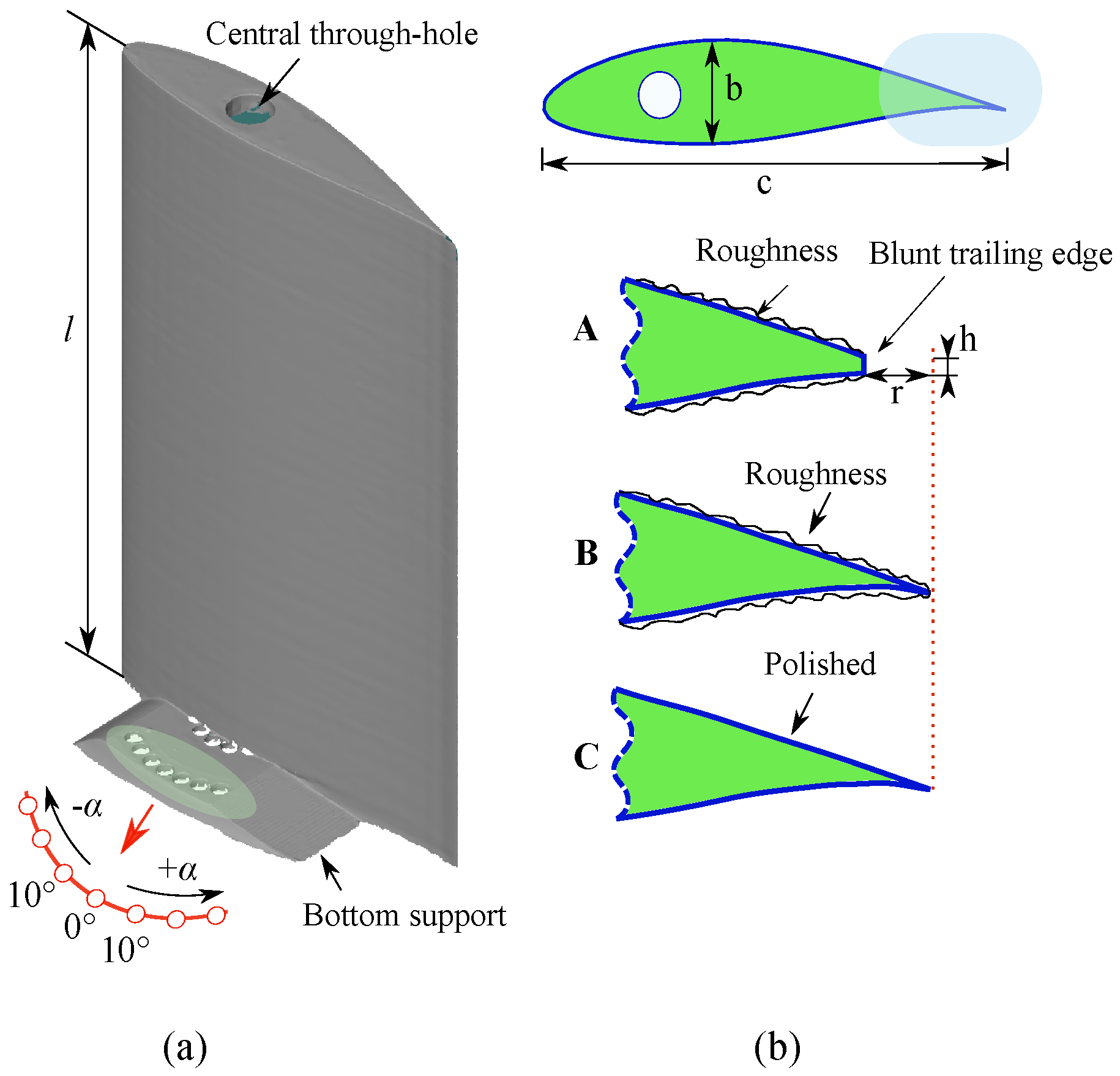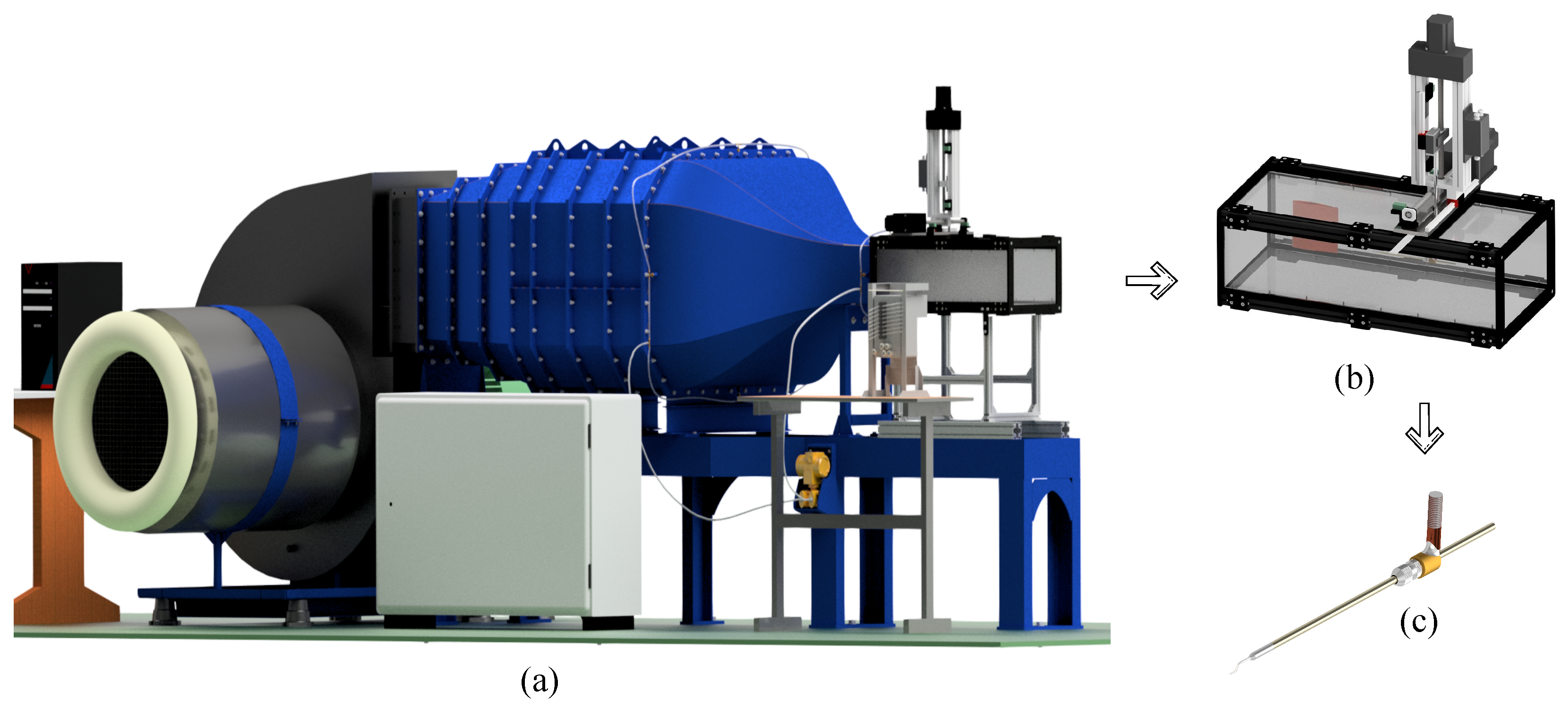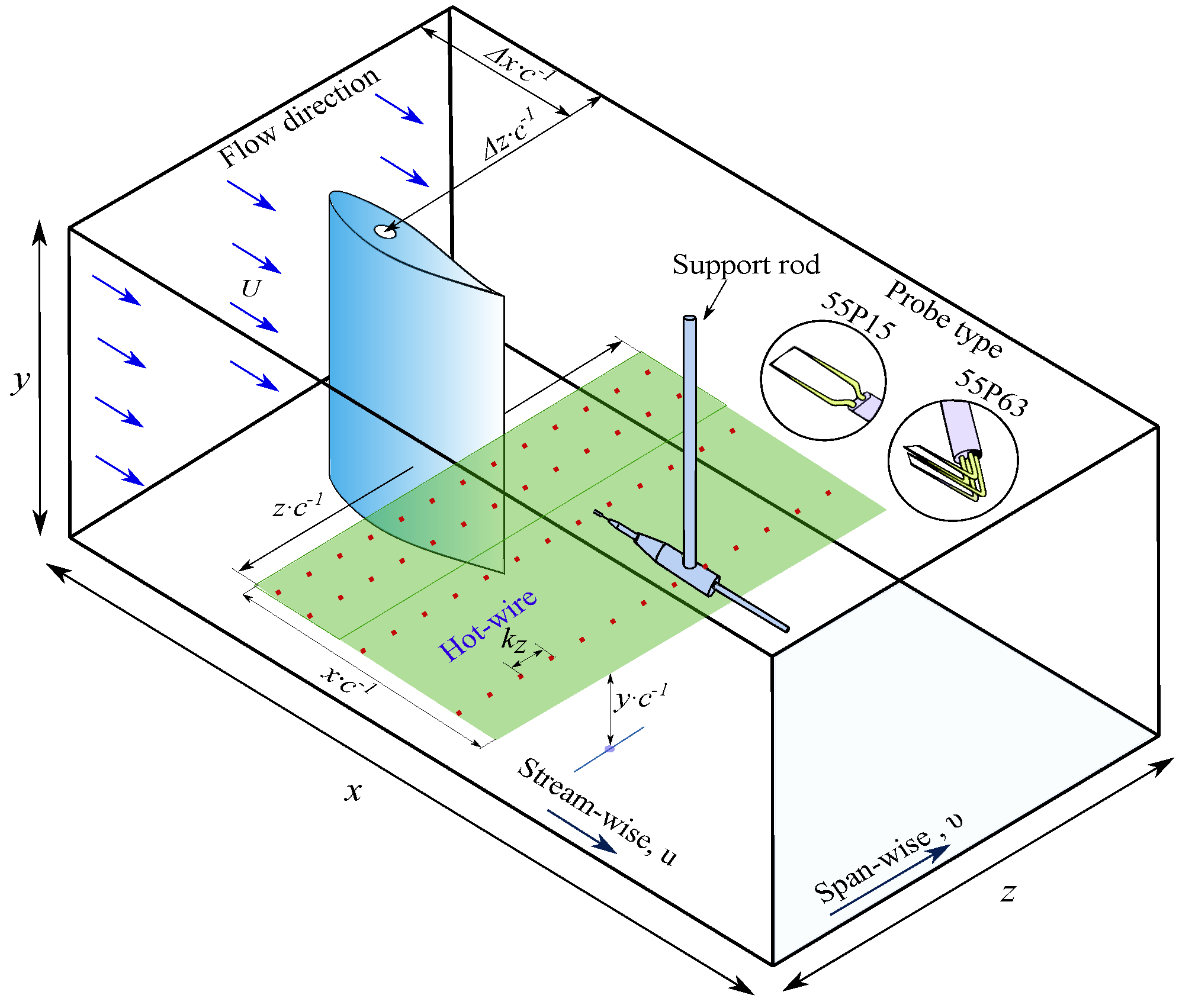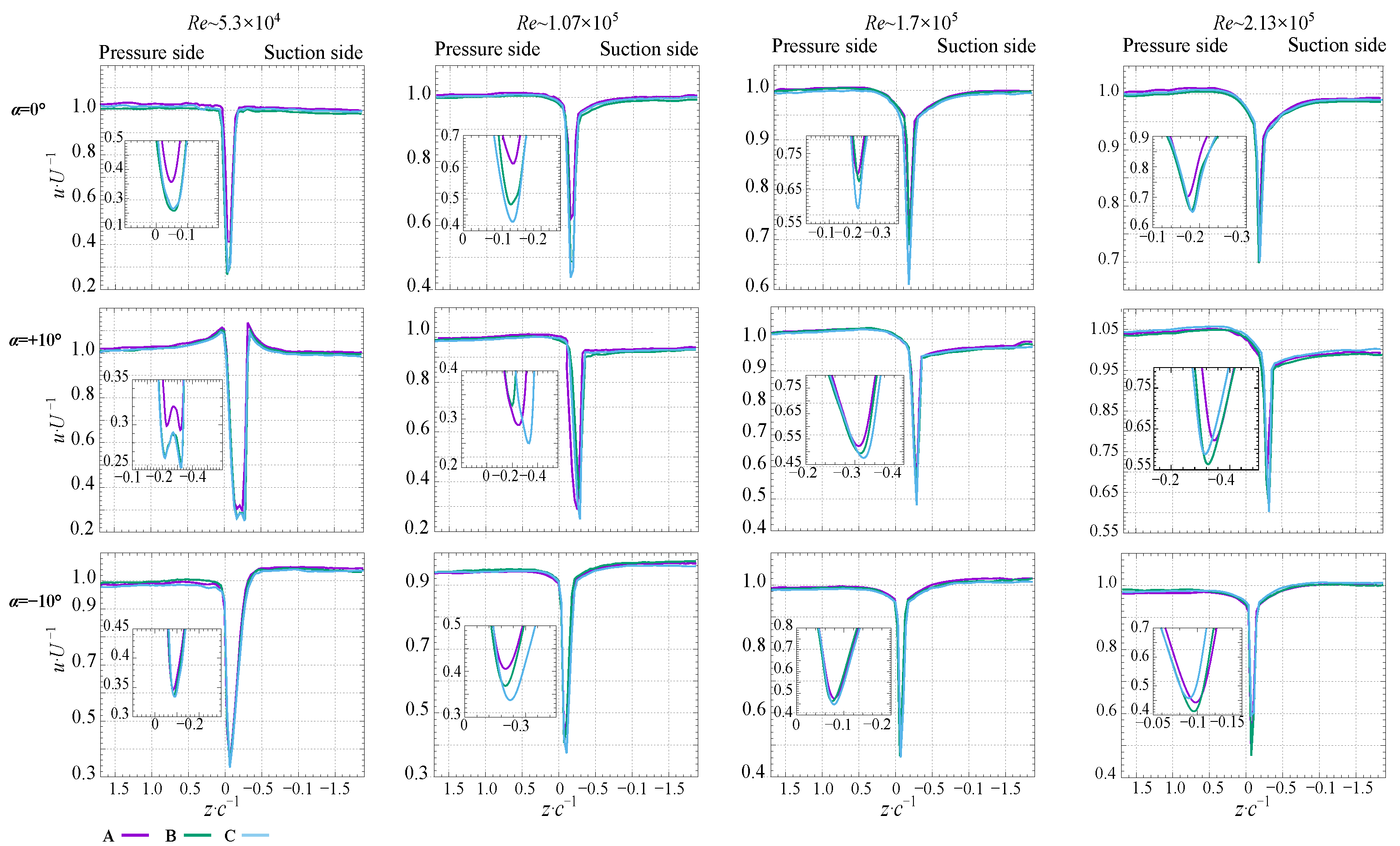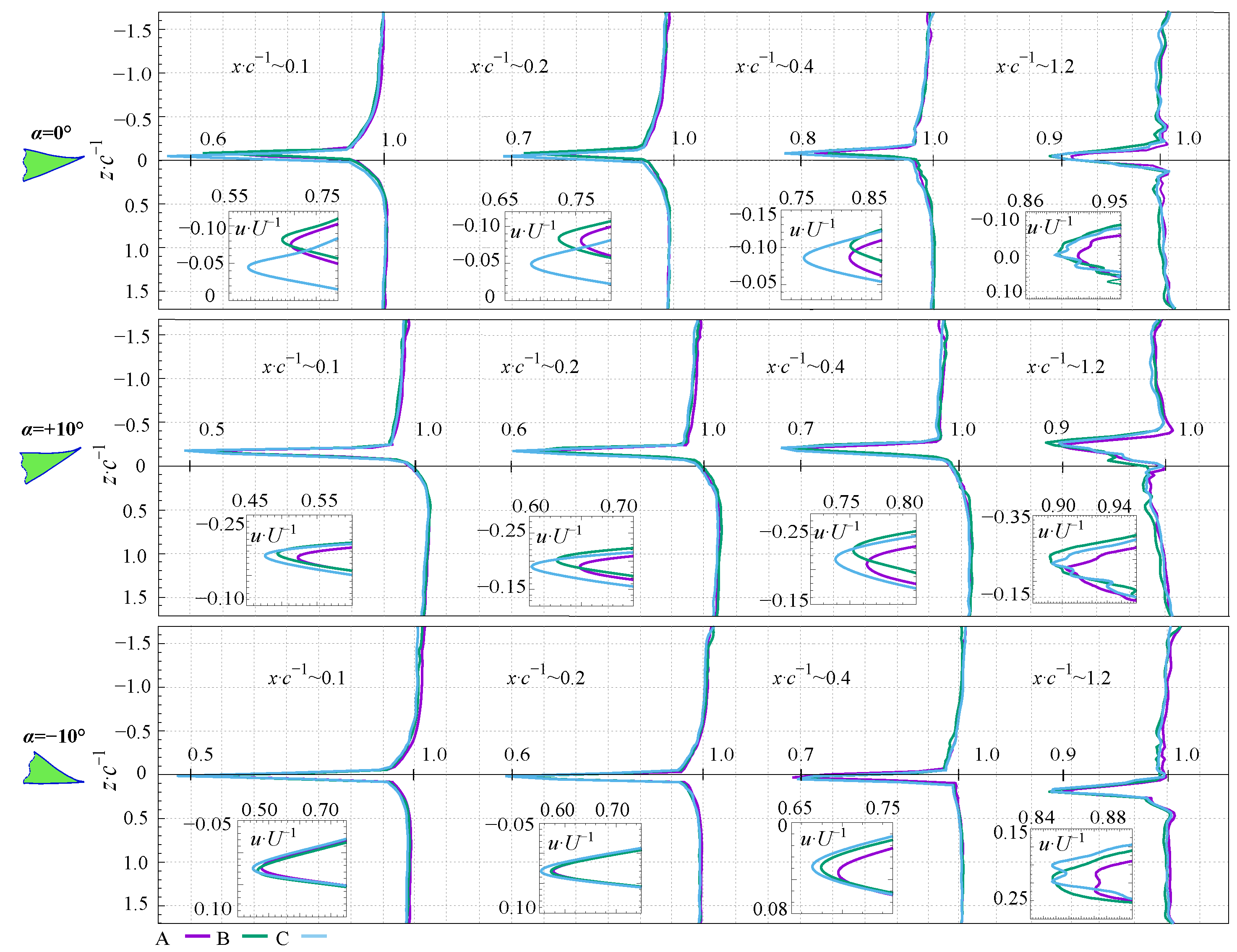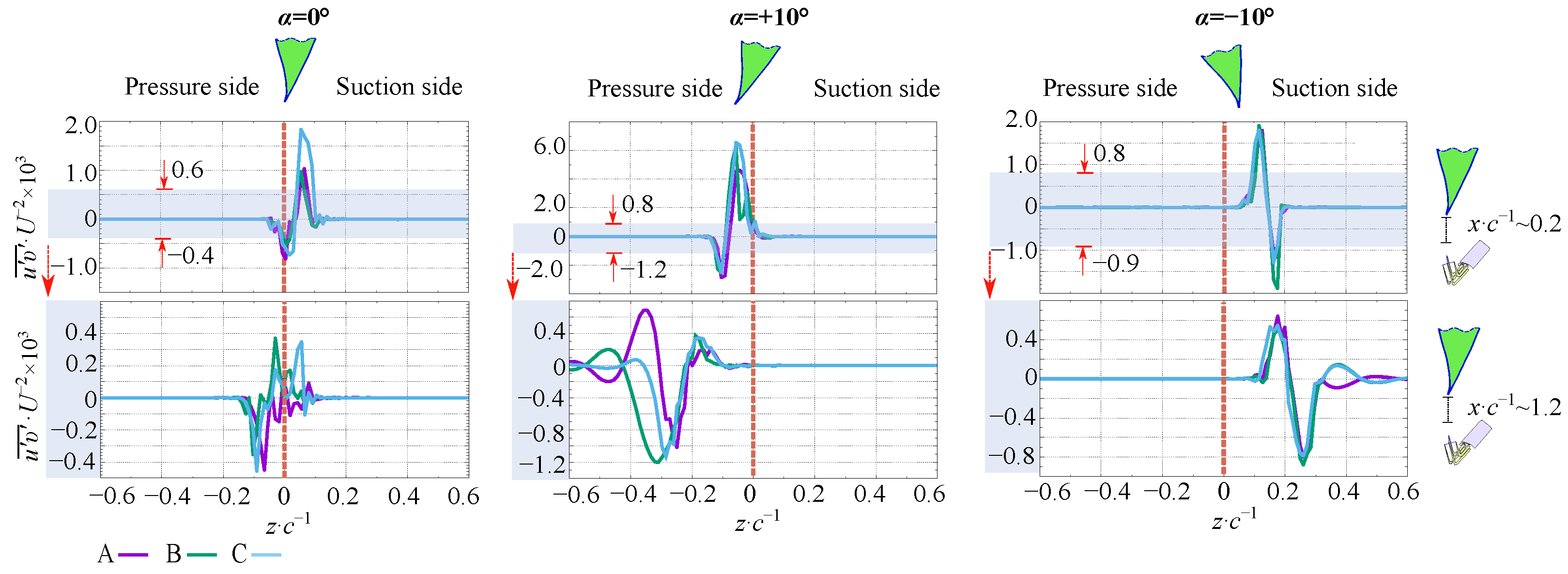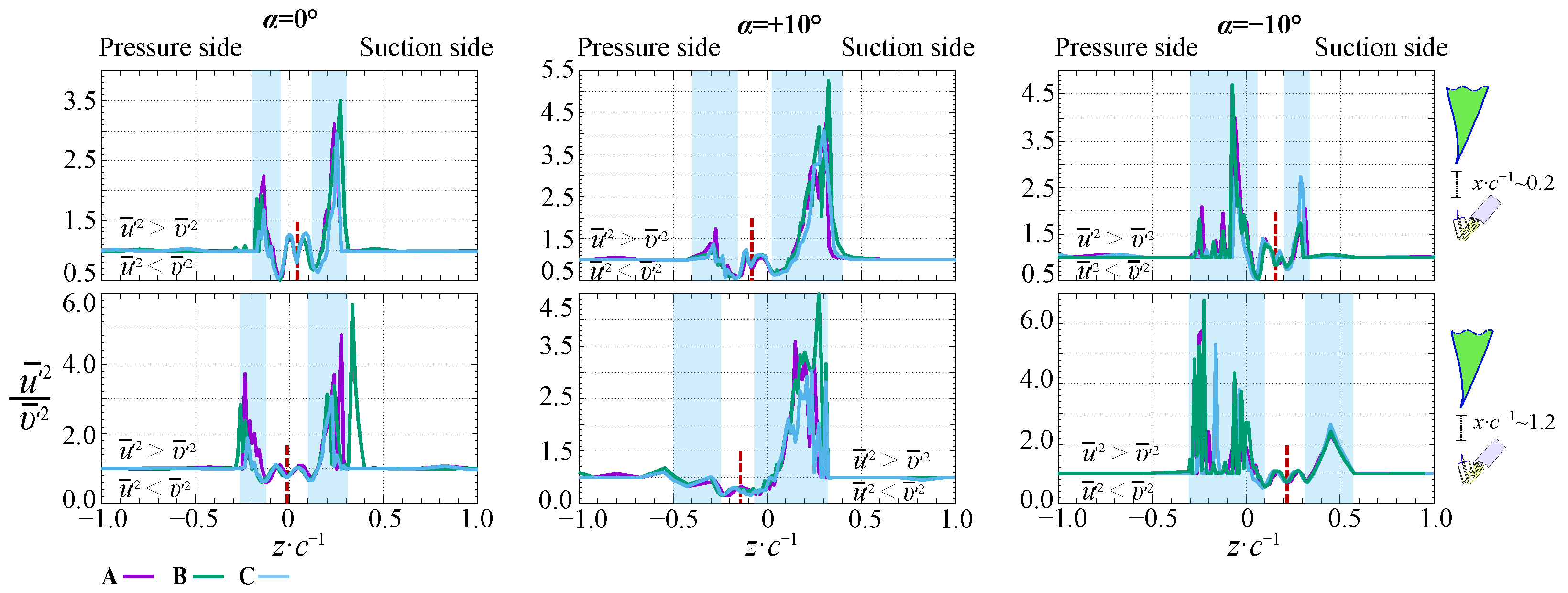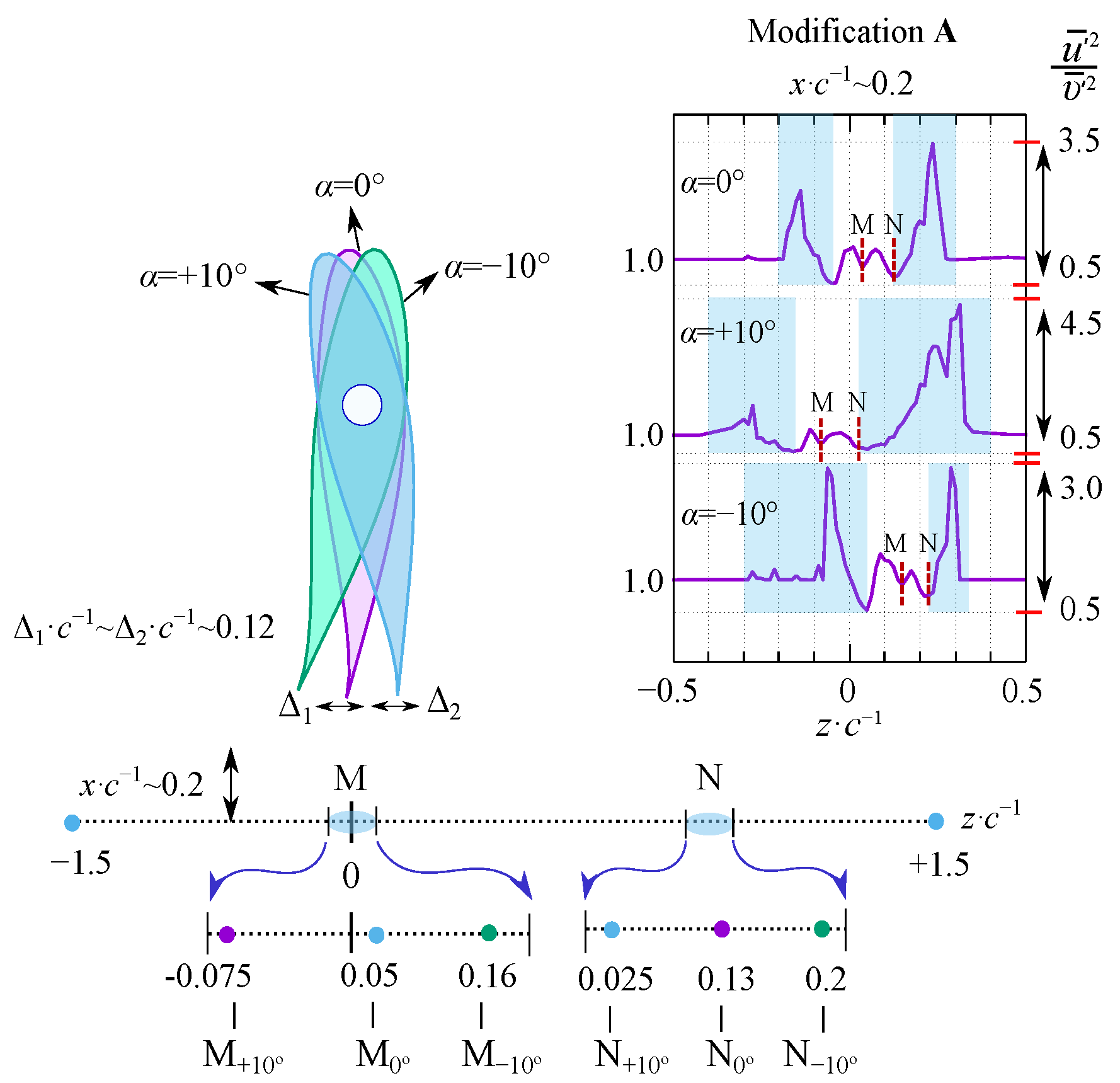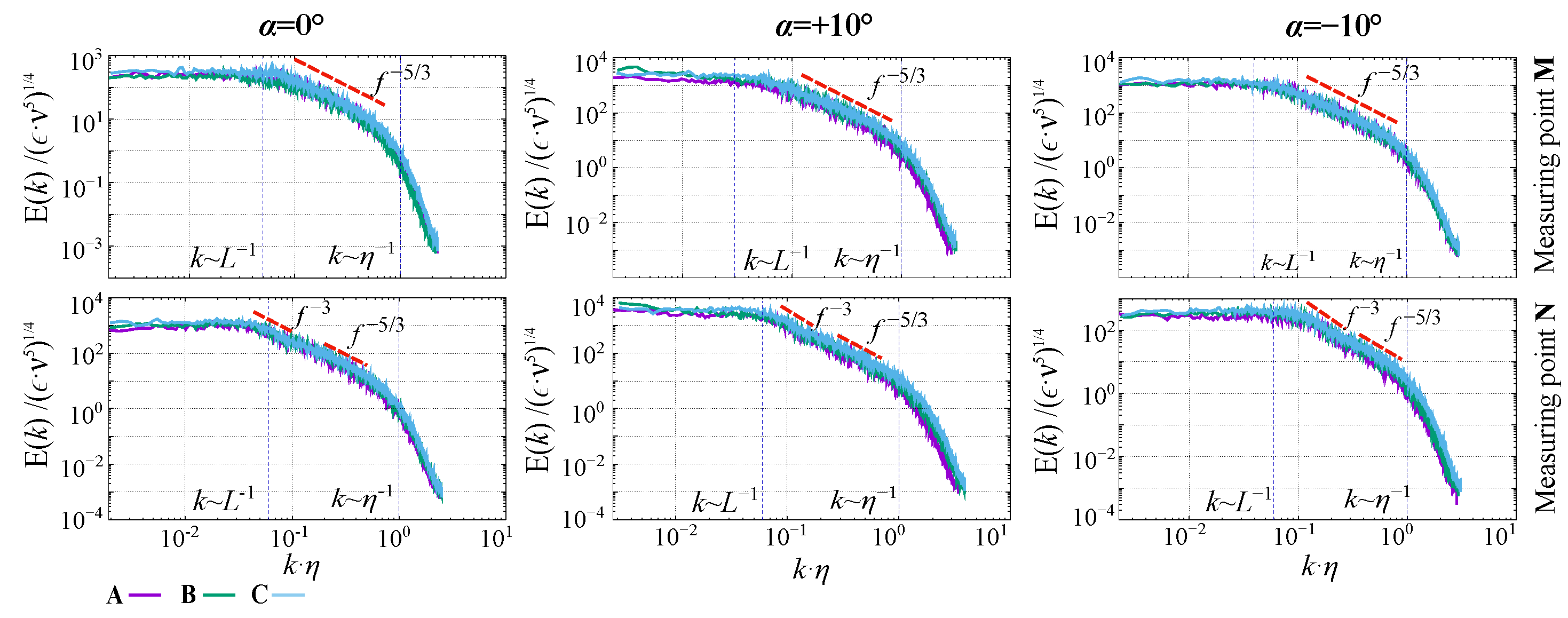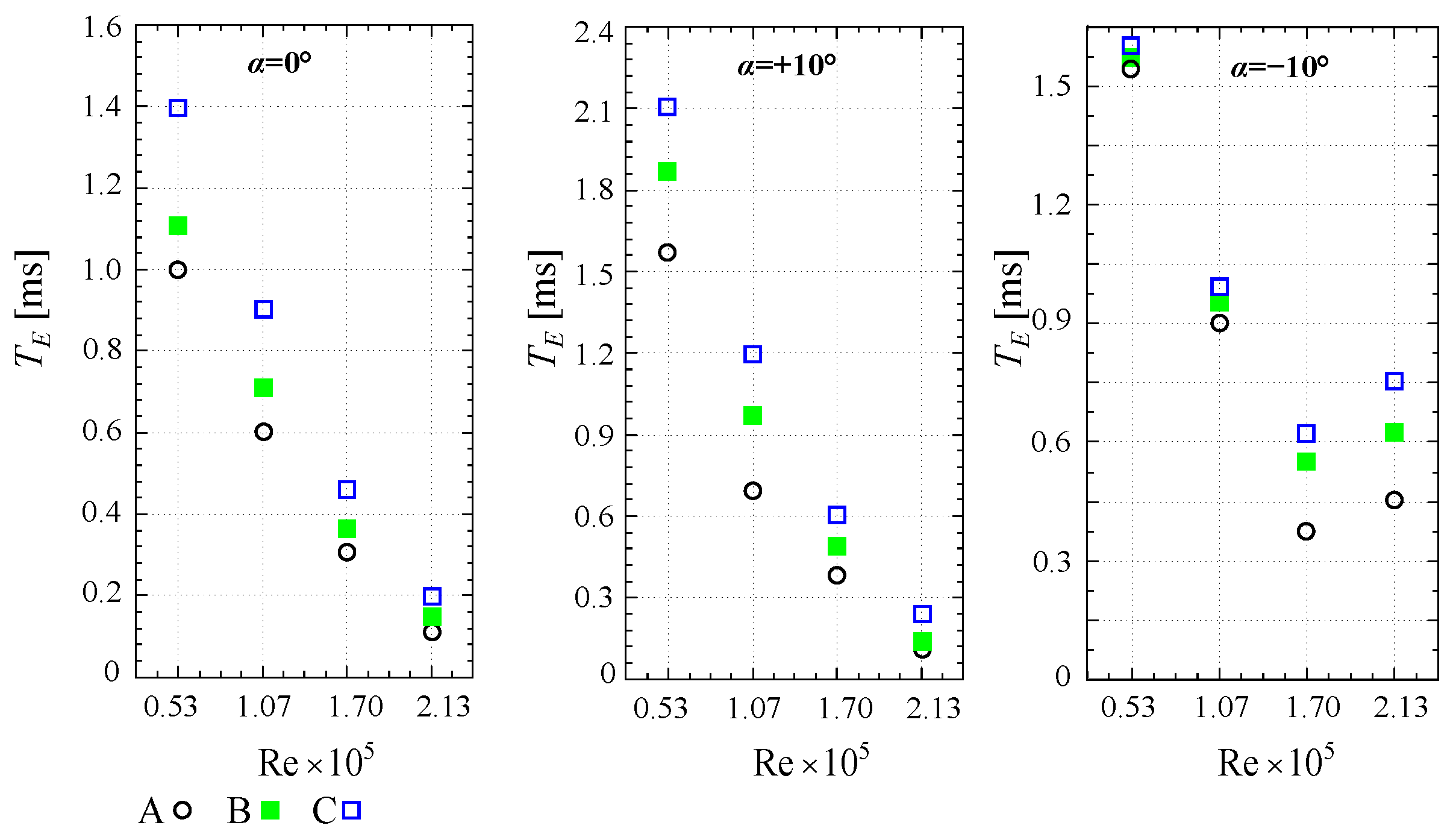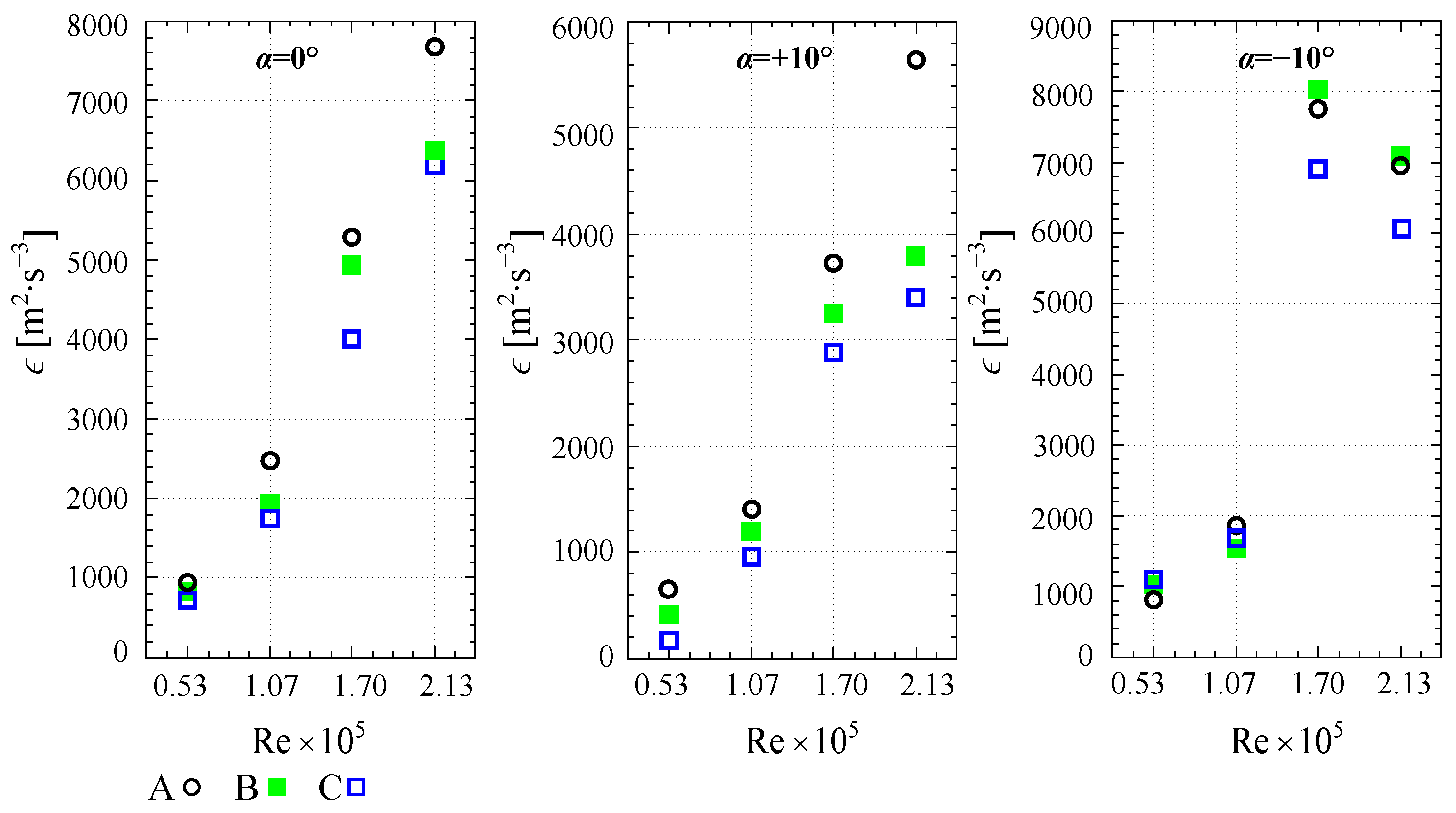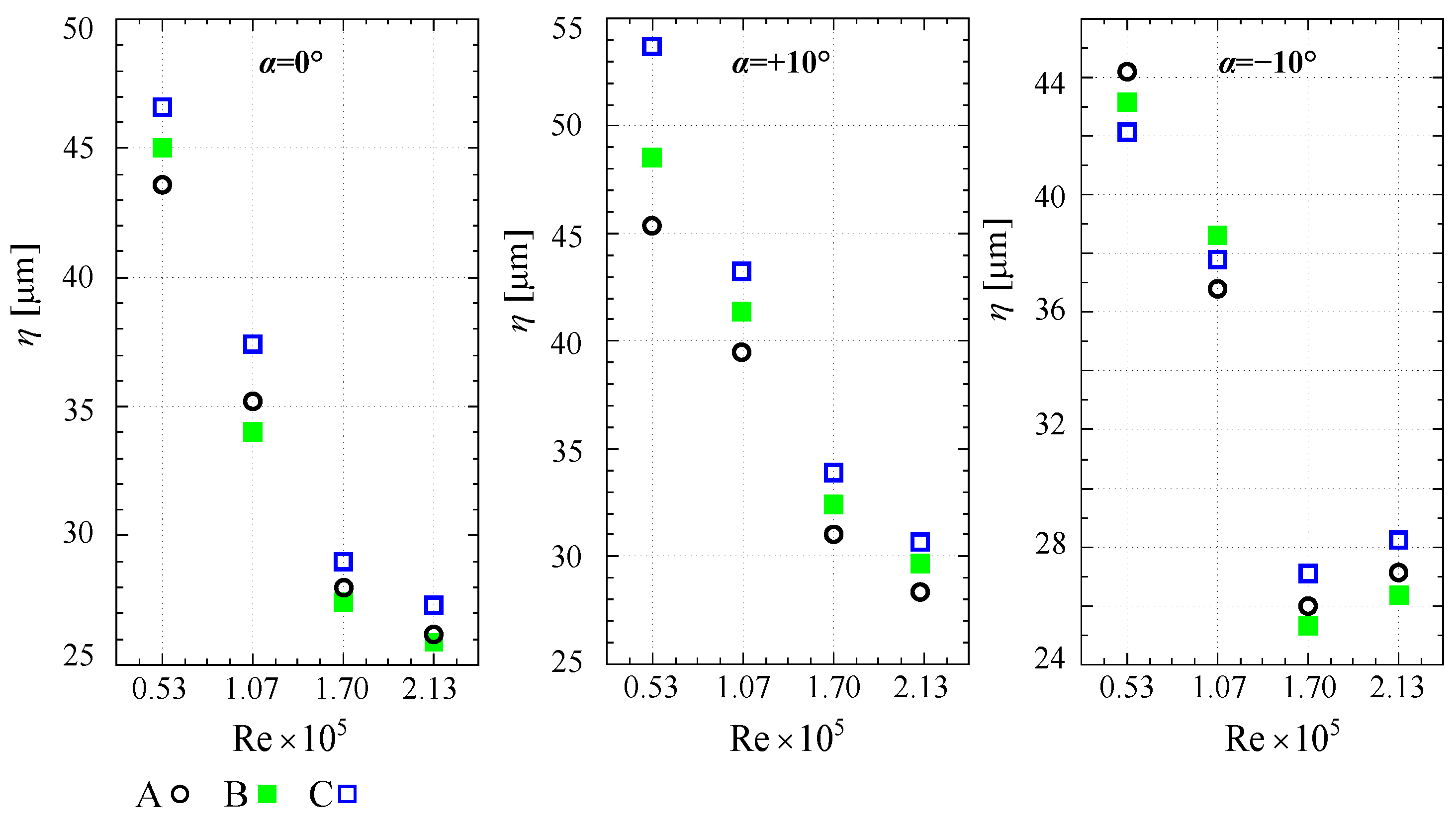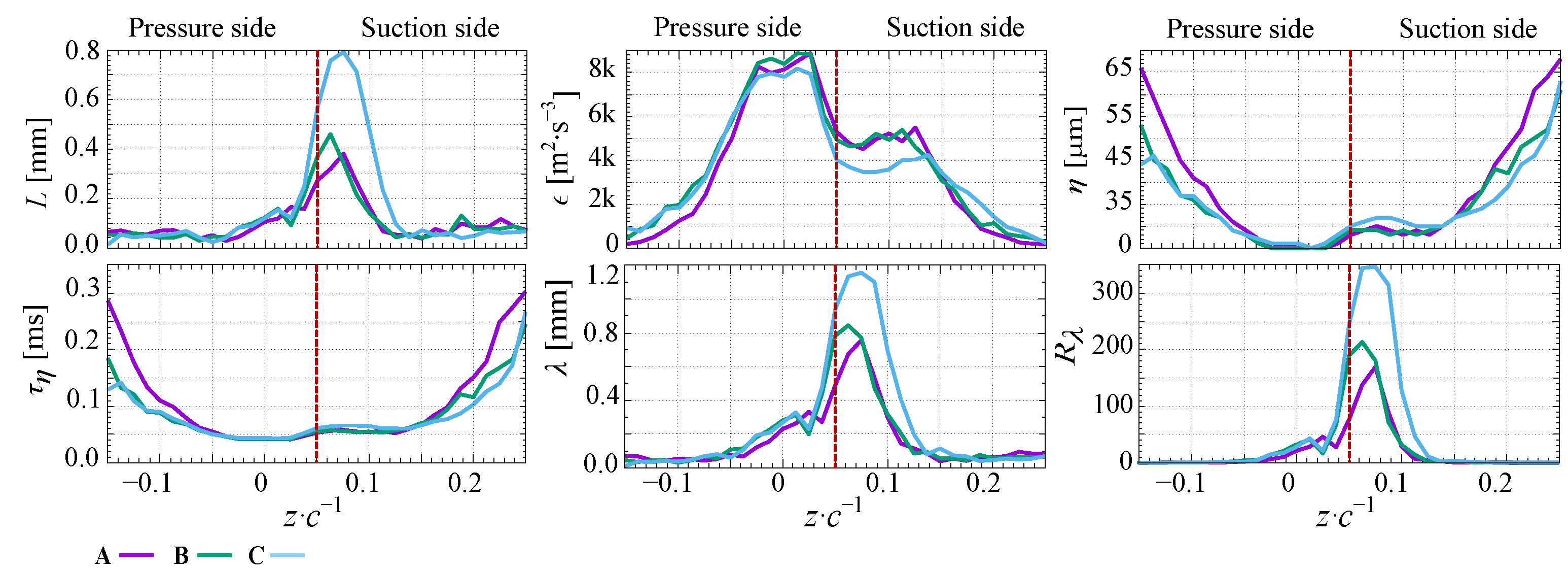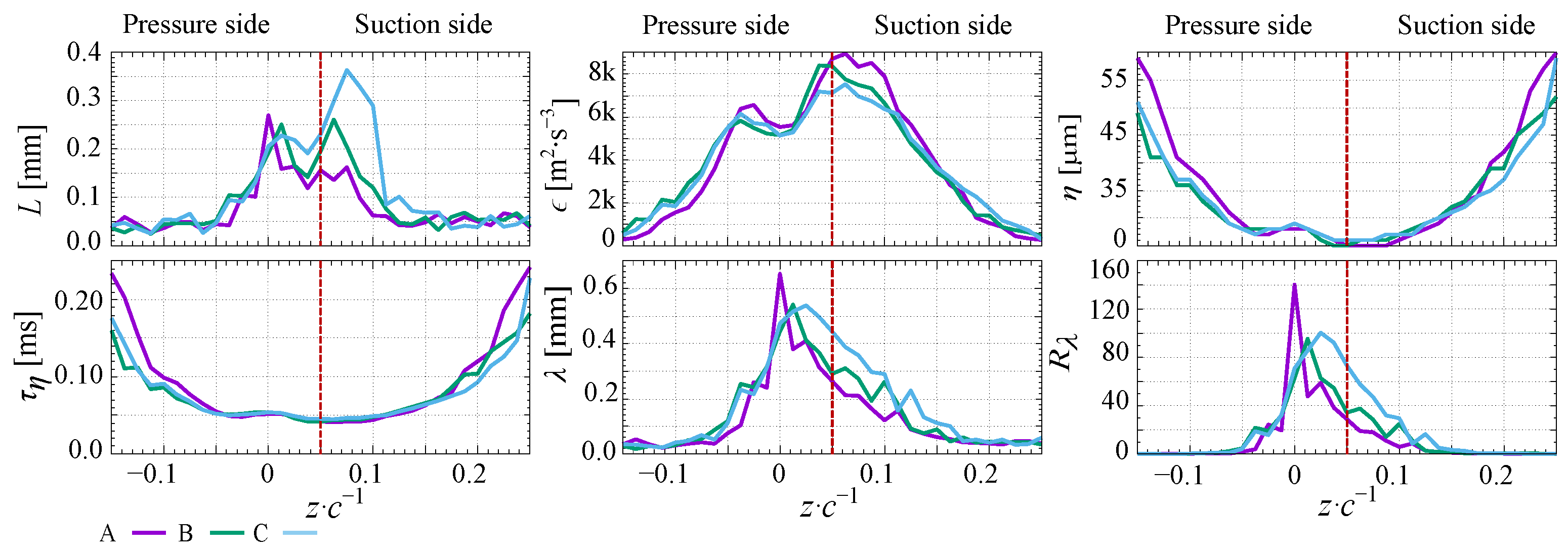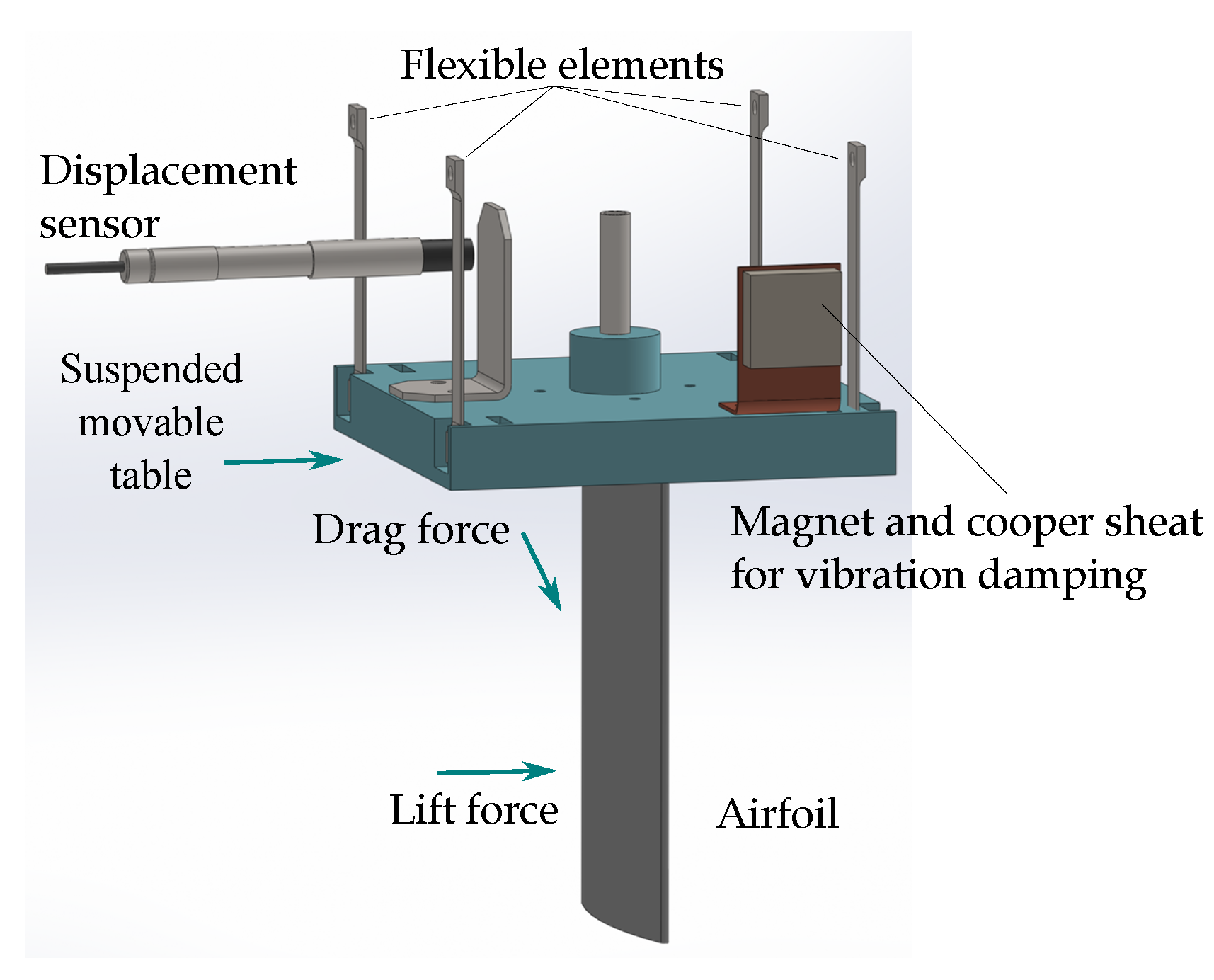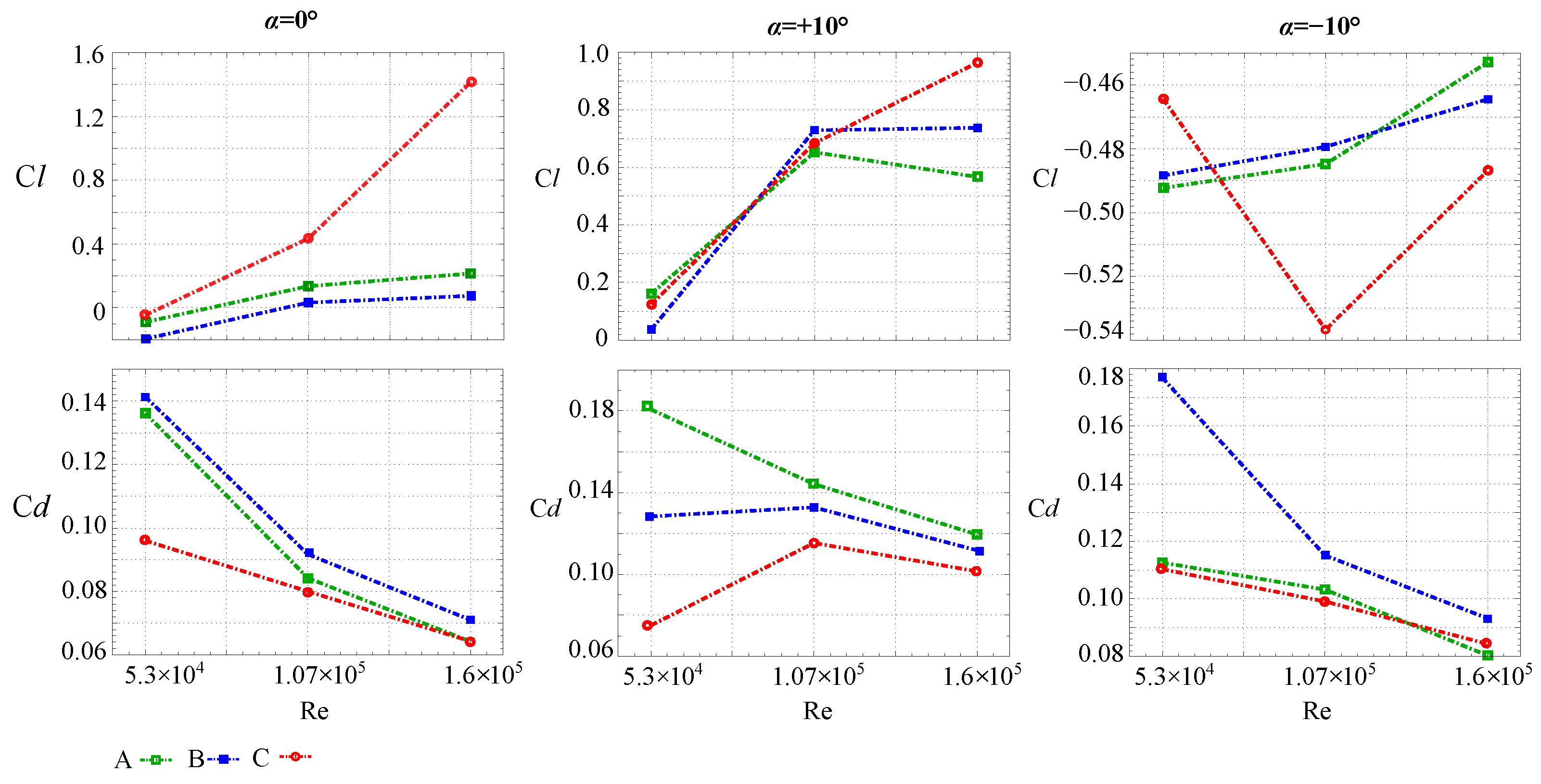1. Introduction
The behavior of the flow around a bluff body is a nonlinear problem. One of the consequences of the nonlinearity is an unpredictable sensitivity on boundary conditions deviations, however small they may be. The scale of possible reactions to some small geometric perturbations ranges from almost zero effect to a complex change of the flow structure. That makes it difficult to predict the turbulence evolution. The situation could be characterized as one of passive low control, however unwanted. Even small variations of the boundary conditions—shape and roughness of the airfoil—could cause important changes in aerodynamic characteristics.
In recent years, a large number of papers were devoted to aerodynamic characteristics of an airfoil. The researchers focused on the spatial and spectral investigation of turbulence parameters. Some of them, based on experiments, were studying in detail the physical aspects of the turbulence formation behind the bladed rotor. Others explored the structure of flow around an isolated airfoil. However, nearly ideal shape of the airfoil is considered for the experimental research with sharp trailing edge and smooth surface, which is far from real application. The airfoil profiles are designed with “absolutely sharp” trailing edge very often, this means that the thickness of the trailing edge approximates zero. This condition could be relatively well approximated in the case of laboratory model, but definitely not in the case of a real machine. The reasons could be technology of manufacturing, strength design or erosion, to mention the most important. The effect of the resulting geometry modifications on an airfoil aerodynamic characteristics was not studied systematically in the available literature. The presented paper is a contribution towards filling this gap.
The flow behind blades has been studied extensively in past. For example, the papers in [
1,
2] show experimental results related to the investigation of turbulence and secondary flows at the outlet of an axial turbomachine. The obtained results contain valuable information about the transport of turbulent structures in unstable, deterministic flow patterns. The authors suggest that turbulence generated at the shear layers is anisotropic. Moreover, they established links between the blade pitch angle and the turbulent intensity.
Meanwhile, other papers [
3,
4] show that higher turbulence intensity or Reynolds number significantly improve the aerodynamic performance of the airfoil. This effect can be observed for all angles of attack. In addition, the intensity of turbulence strongly affects the boundary layer characteristics [
5]. This plays an important role in the formation of flow behind a streamlined body, therefore, many researchers have focused on this issue. Moreover, the formation of a boundary layer is nontrivial and depends on the surface quality and geometry of a body [
6]. The profile of an airfoil can be either symmetrical or asymmetrical. The work in [
7], presents an investigation of turbulence quantities in the boundary layer and near-wake of the symmetric airfoil at different angles of attack. The authors demonstrated how a modification of the boundary layer affects the development of the wake. Some similar studies, but for the asymmetric airfoil, are performed in [
8]. The authors describe the structure of the turbulent flow in the wake and boundary layer regions in detail. In addition, they define the transition range between instability and free stream zone based on spectral and anisotropy analyses. Generally, the pressure gradients are different across asymmetric and symmetric airfoils. Accordingly, under increasing turbulence intensity, for asymmetric profile, the maximum lift is reduced by 30%. Whereas, this characteristic for a symmetrical profile, on the contrary, increases by 5% [
9].
Nowadays, many researchers also pay attention to the quality of an airfoil surface. Since even a slight roughness of the streamlined body significantly changes the structure of the wake flow [
10], it shifts the transition to turbulence and the separation points. The first fundamental result investigations of this phenomenon are presented in the works in [
11,
12]. The authors discovered that roughness leads to activation of mixing and turbulent transport processes in the boundary layer. The laminar–turbulent transition of the boundary layer could be accelerated, the bypass mechanism could take place. This causes boundary layer thickening and increasing turbulent diffusion in the generated wake [
13,
14]. On the other hand, the turbulent boundary layer is more resistive to separation, this effect could render the wake thinner. Moreover, there is a strong dependence between the location of transition inception in separation bubbles and the roughness value of the surface [
15]. In addition, the roughness has a strong effect on the general turbulence properties, which results in an increase in turbulence intensity and Reynolds shear stress [
16]. This behavior in turn leads to an increased heat-transfer coefficient and friction factor [
17]. The results of many experimental studies confirm this pattern. For example, in [
18,
19,
20], the authors investigated how the blade cooling process depends on roughness. As a result, they noted that with micro irregularity, the heat-transfer rate grows significantly.
Moreover, the geometry of the streamlined body is one of the fundamental reasons for the appearance of airfoil self-noise. This is a typical effect of the airfoil interaction with the turbulence produced by the boundary layer [
21,
22]. Many researchers, using different methods, have investigated this phenomenon [
23,
24]. Their results show that the airfoil self-noise is significantly dependent on the trailing-edge geometry and quality of the streamlined surface [
25,
26,
27,
28].
An airfoil is typically defined by its contour by large number of points with exactly defined coordinates. As a rule, the trailing edge is “sharp”, meaning that the thickness of the airfoil at the trailing edge approaches 0. This condition concerns our profile NACA 64-618. The reason for this choice is historical, the Kutta–Joukowski theorem is used for the lift estimate, which requires a sharp trailing edge, see, e.g., ref. [
29].
The problem is that the absolutely sharp trailing edge could not be made in practice for technological reasons [
30]. Moreover, the size of the airfoil—its chord length—is very different between a real machine and a physical model used during aerodynamic experiments in wind tunnels. The scale could be 1:10, however, the thickness of the trailing edge and roughness of the surface are more or less the same, given by the manufacturing technology. For example, the real thickness of the trailing edge could be about
, the same for both the model (chord
) and the real application (chord
). This means that the real chord is shortened by approximately the same factor about
for the model (representing
error) and the application (error only
), respectively. This modification definitely has a very different effect on the two cases’ flow-fields around the airfoils. Therefore, the geometry similarity is not maintained in physical modeling very often.
Please note that a rounded trailing edge is not necessarily cost-effective. It is known that the airfoils with blunt trailing edge could show a very good performance [
31]. However, the flow-field is completely different, especially in structure and size of the wake, see, e.g., ref. [
32,
33]. This influences the pressure drag generation directly. This effect will be addressed in our paper in detail for the specific airfoil. However, the conclusions could be considered more general, at least in a qualitative sense.
In general, the flow evolution around an airfoil strongly depends on its geometry. Even the slightest deviation from an original shape leads to different flow quality, which significantly changes the aerodynamic characteristics of blades. Usually, shape inaccuracies can occur during the production or operation of the streamlined body. In the first case, this is due to technological factors in setting up and organizing the production process. Whereas, in the second, it is associated with the corrosion process [
34] or depositions on surface. That is especially an issue for offshore wind turbines, where the blades are in a salt fog environment.
As we can see, the general evolution of the flow around an airfoil is strongly dependent on its geometry. Even the slightest deviation from a given shape can lead to different phenomena. The study of this issue is especially important in the production of various streamlined bodies.
That is why, in this paper, we investigate the impact of the most common airfoil shape inaccuracies on the flow structure behind it. The organization of the remaining parts of the paper is as follows. Methodology of experimental investigations and parameters of the measuring devices are given in
Section 2. That section describes the procedure of NACA 64-618 airfoil productions and its modifications for the experiment, as well. Then, the results obtained by hot-wire anemometry are presented in
Section 3. In particular, we discuss the features of the wake characteristics, Reynolds stress components, and the degree of flow anisotropy according to airfoil shape error, Reynolds number and angle of attack. Moreover, for some measuring points, the power and dissipation spectral distributions are analyzed. Afterwards, the effect of airfoil shape inaccuracies on the structure of turbulence (
Section 4) and aerodynamic forces (
Section 5) is evaluated. Finally,
Section 6 reports the conclusion.
3. Results and Discussion
3.1. Measuring Techniques
The constant temperature anemometer was used to study the turbulent structure behind the airfoil. The basic principle of this device is to compensate for the thermal state of the hot wire [
39,
40]. The Wheatstone Bridge is used to measure the variation of the wire resistance relative to its temperature. In the case of wire cooling, the operating system of the device instantly supplies more energy to the wire. This is necessary to maintain a constant wire temperature. Thus, the power provided to support the system corresponds to the cooling rate and thus to the value of flow velocity passing by the sensor.
Experimental studies were performed using two types of hot-wire probes. In most cases, we used a miniature wire probe type 55P15. For some measuring points, we also used a miniature X-wire probe 55P63. That allowed us to investigate in more detail the two-dimensional structure of the turbulent flow (u and components). The wire probes with tungsten platinum coating have a diameter of 5 m and an active length of , while the ends of wire are gilded. The hot-wire signals for all experiments were sampled at . The filtering of the received signal was applied as well. For the high- and low-pass filter, the frequency was , and , respectively. The typical duration of a single point measurement was .
The StreamLine system from the company Dantec was applied to calibrate the velocity sensors. This system includes units for generating the flow and supply of dried air. The Collis–Williams law was used to calibrate and estimate the instantaneous flow rate [
41,
42]. This method is well described in many papers, see, e.g., ref. [
43]. The method uses dimensionless description of the sensor cooling law using Reynolds and Nusselt numbers. This approach allows for compensation of pressure and temperature deviations during the experiments.
The precision of measure velocity was determined using the classical methodologies [
44,
45]. The analysis performed shows that the general uncertainty of the conversion process of the probe electrical signal to the velocity sample is around ±0.5%. This value, in the case of X-wire, is approximately equal for measurements in the streamwise and spanwise directions. Please note that the relative error is related to the maximal velocity, which was in the rage 10–40 m·s
, depending on the Reynolds number value.
The velocity time series are subjected to statistical data treatment—see, e.g., ref. [
46]. LabVIEW and Gnuplot have been used to postprocess the data and produce all the plots presented in the experimental parts of this paper. The Welch method was applied to estimate the power spectral density of a one-dimensional time series. In addition, the solve function was used to determine the calibration constants of the hot-wire probes.
3.2. Wake Topology
A series of experimental studies were performed using the hot-wire probe 55P15. This section presents the analysis of velocity (only the dominant streamwise component u is measured) depending on the airfoil shape inaccuracies (), angles of attack, Reynolds number and measuring position .
The experimental program is divided into two measurement campaigns. In the first part, the turbulent flow was investigated close to the trailing edge at different Reynolds numbers. Accordingly, the experiments were conducted at and , , , , what corresponds to 10, 20, 32, . Whereas, the second campaign took place at constant Reynolds number and different measuring positions , , , . For better visualization, the obtained data were placed relative to the position of the trailing edge at and normalized by the free-stream velocity U.
As expected, the obtained results showed a significant effect of the Reynolds number and the angle of attack on the wake characteristics. In particular, as the Reynolds number grows, the depth of the wake increases. The wake width strongly depends on the angle of attack and is the largest at
. As we can see from
Figure 5, the largest and smallest wake velocity deficits are characteristic at the
C and
A modifications, respectively. Moreover, at zero angle of attack, the difference between them is almost
. It is caused by that modification
A, in contrast to
C, has a 4 times greater surface roughness,
shorter chord length, and
thicker trailing edge. Thus, according to the experimental data at
, when the Reynolds number increases to ≈
, the wake velocity deficit behind
C modification at
,
and
increases by
,
and
times, respectively.
Moreover, at
and the positive angle of attack, the obtained velocity distributions also indicate the presence of a double peak. This phenomenon occurs as a result of the vortices’ interactions with pressure and suction sides of the airfoil [
33,
47]. Whereas, in other cases, the absence of a double peak means that the flow contains only a single dominant structure. Additionally, the experiments clearly show the displacement of the wake center depending on the angle of attack. This effect occurs due to the difference in flow velocity from different airfoil sides.
In addition, we investigated the effect of airfoil shape inaccuracies on the wake evolution at increasing distances from the trailing edge. As shown in
Figure 6, the wake depth reduces with increasing distance, while the wake width grows as the wake gradually wastes. At the same time, the wake center at
and
shifts to the pressure side while at
, it is the contrary. Meanwhile, the absent airfoil shape error leads to a growing velocity deficit. Accordingly, at each measuring cross-section behind the airfoil, the velocity curve for
C has a deeper wake than for
A and
B modifications. In particular, this pattern is clearly visible at zero angle of attack.
3.3. Reynolds Stress Tensor and Degree of Anisotropy
The Reynolds stress tensor was applied to estimate the effect of airfoil inaccuracies on the flow anisotropy. Usually, the Reynolds stress tensor has six independent components that characterize the flow relative to the spatial directions x, z, and y. However, in our case, due to the application of the X-wire probe 55P63, which measures only streamwise and spanwise components, the Reynolds stress tensor was statistically .
The analysis of flow characteristics took place at two measuring positions
and
at
. For graphical interpretation, the obtained data were normalized by the squared free-stream velocity (
Figure 7).
The obtained data indicate that the magnitude and the distribution of the normal stress components strongly depend on the slightest deviations in the airfoil shape. For example, closer to the trailing edge and , the value of for C modification by and times greater than for A and B, respectively. This explained is due to the variation of the trailing edge and the surface roughness of the airfoil.
With increasing distance to , the value of normal stress components decreases significantly. This is especially noticeable at , where there is a meaningful dissipation of vortex energy.
In addition, the comparative analysis of the
and
distributions reflect the double peaks. This phenomenon is more detail described in papers [
7,
48,
49]. The authors claimed that at a positive angle of attack the double peaks more noticeable. However, in our case, this phenomenon is more visible at the
and
. That is because, for our studies, we used the NACA 64-618 airfoil. This is not only asymmetric but also has some concavity on the pressure side. Thus, the vortices which formed on the pressure and suction sides can propagate in the flow together. Whereas, at
, the vortices passing from the suction side are increased by vortices from the pressure side. This interaction leads to the formation of a dominant vortex from the suction side in the general flow.
In addition, we also analyzed the effect of airfoil shape inaccuracies on the Reynolds shear stress distributions (
Figure 8). Physically, this component is related to the diffusion mechanism for the transport of fluid momentum. Moreover, using the
distribution, it is possible to clearly define the region of flow instability where the turbulence structure is anisotropic.
Graphical interpretation of the obtained data shows that, in the perturbation area, a negative value is located directly on the pressure side. This indicates that the turbulence intensity at this location progresses and consequently increases frictional resistance in the mean flow. As a result, turbulence receives energy, while the average flow loses it.
The obtained data show that the largest magnitude of the shear component occurs at the positive angle of attack and closer to the trailing edge. Simultaneously, at and the magnitude of is three times smaller. Note the influence of shape inaccuracies on the obtained distributions observed at and . At this angle, the maximum of the shear stress component is times lower for A and B than for C modifications. Whereas, at any effect of inaccuracies almost disappears.
According to the experiments, with increasing distance from the trailing edge, the width of the instability region increases, and its depth declines. This pattern is clearly traced for the A modification. That is due to the presence of additional vortices formed by the blunt trailing edge of the airfoil.
As noted above, the Reynolds stress tensor characterizes the turbulence anisotropy [
50,
51]. Namely, when the flow fluctuations are statistically uniform in all directions, then the shear stress goes to zero and the normal stresses become equal. Otherwise, at
and
, the turbulent flow is anisotropic. To quantify the degree of anisotropy, the Formula (
1) could be applied, which represents the ratio of velocity component fluctuations.
where
and
represent time-averaging value of velocity fluctuations in streamwise and spanwise direction, respectively.
Values of
greater or smaller than 1 indicate the dominance of the spanwise or streamwise component, respectively. Graphical interpretation of the obtained data at different measuring sections depending on the angle of attack is shown in
Figure 9.
As we can see, the width of the anisotropy region is much bigger than the instability region determined by Reynolds stresses components. Comparing these two distributions, we can clearly define the range that characterizes the boundaries of the shear layer (the blue area on
Figure 9). In the figure, the instability of the flow is much lower than in the wake. Thus, at some points, even with the smallest difference between the Reynolds stress components, the flow is more anisotropic.
A similar analysis technique is presented in paper [
8]. In the study, the authors carefully investigated the flow structure around the FX 63-137 airfoil model. They note that there is some “transit zone” between the free stream and the wake instability region. A feature of this zone is an atypical distribution of power spectral density. Namely, the inertial range has a double slope.
Additionally, as we can see from
Figure 9, in the region of Reynolds instability, the DA distribution has a double peak with a local minimum
M. This point corresponds to the minimum of the streamwise velocity and the inflection point for the shear stresses distribution. Moreover, the greatest degree of anisotropy observes close to the free stream, where streamwise fluctuations are dominant
. Whereas, near to the wake, on the contrary, the transverse fluctuation is higher than the longitudinal one
.
In addition, the areas of the shear layer with the maximum anisotropy values are wider, and their position strongly depends on the angle of attack. For example, at and , they are observed from the suction and pressure side, respectively. Additionally, at the negative angle on the pressure side, a significant number of small vortices are generated. These are clearly expressed in the longitudinal direction.
In general, we can conclude that minor manufacturing inaccuracies of the airfoil do not have a significant effect on flow anisotropy. The main factors of this phenomenon are the general geometry of the airfoil and the angle of its attack.
3.4. The Spectral Analysis
The feature of turbulent flow is the presence in its structure of different spatial scales. Power spectral density is widely used to estimate the distribution of energy flux intensity between components of these scales. Physically, it shows the pattern of distribution in the time domain of signal power over the different frequencies.
To spectrally estimate the structure of the turbulent flow, we chose two measurement points,
M and
N. Accordingly, the first of them is located clearly at the local minimum of the longitudinal velocity component, while the second one is placed on the beginning of the shear layer. The Reynolds number was
. It is clear that at different angles of attack, the coordinates of the measuring points
M and
N will be changed (see
Figure 10).
For representing normalized Eulerian power spectral densities of streamwise velocity fluctuations, we used the Kolmogorov nondimensional coordinates (
Figure 11). Accordingly, the obtained spectrum was normalized by
and the wave number by
, with
,
and
representing dissipation scale, dissipation rate and viscosity, respectively. The method of estimating these parameters is show in
Section 4.
As it is known, according to Kolmogorov’s law, the spectral density of turbulence energy decreases with increasing wavenumber. Moreover, in the inertial subrange, the curve has a characteristic slope of
[
52,
53]. This pattern is clearly observed for point
M, whereby, in longitudinal and transverse directions, the turbulent fluctuations are statistically uniform. Our previous investigations show that at
M, the turbulent flow is isotropic. Whereas, the opposite is valid for
N in the shear layer. Moreover, this point has a double slope
after that of
in the inertial subrange. This tendency is observed at various airfoil modifications and different angles incidents. Thus, based on the behavior of the energy spectrum, we assume that point
N can be determined as the place where the wake instability ends and the shear layer begins.
Additionally,
Figure 11 shows that the width of the inertial subrange significantly depends on the angle of attack. Physically, this subrange shows the interval where turbulence kinetic energy is transferred from larger to smaller scales without loss. The largest and smallest width of the inertial subrange is observed at
and
, respectively.
In addition, the dissipation spectrum for the points
M and
N was evaluated (
Figure 12). The dissipation occurs at a high wavenumber, where the smallest vortices dissipate turbulent energy due to viscosity. The magnitude of this phenomenon can be estimated by Formula (
2).
For non-dimensional coordinates, we used normalization in the form
and for wave number
. The data obtained show that at point
M, the energy dissipation distribution has a classical form. Namely, the curve in the inertial subrange has a slope of
. A similar result for homogeneous isotropic turbulence was obtained by Pope [
54]. However, for point
N at the beginning of the dissipation range, there is some convexity. After that, the curve has the slope of
. This feature is detected only in the place where the shear layer begins. Moreover, the flow characteristic at point
N varies greatly depending on the type of shape inaccuracies. In particular, at
, the value of turbulent kinetic energy for modification
C is much greater than
A. This pattern is quite logical. In the first case, the airfoil has the best geometry and low surface roughness. That is why the flow receives less resistance. Whereas, for modification
A, at turbulence, the flow undergoes a large energy dissipation. However, in any case, we can see that even a small change in the airfoil configuration changes the flow structure.
5. Lift Coefficient Determination
The aerodynamic balance was applied to estimate the effect of shape inaccuracy on the airfoil lift and drag forces [
60].
Figure 20 presents a sketch of the developed aerodynamic balance.
The main structural parts of the balance are a resiliently suspended movable table and an eddy current sensor. Meanwhile, the elastic suspension consists of four parallel flexible elements, which have the lowest stiffness in the lift direction of lifting force. The displacement of the table is measured by an eddy current sensor which responds to the distance to the steel target. Unwanted vibrations are dampened by eddy currents in the copper sheet as it moves near to the neodymium super magnet. The sensor output is calibrated by a known force created by using a calibration weight in the lift or drag direction. It should be noted that the measurement error of this device was approximately 1.2%. This error was caused by unwanted airfoil oscillations and to shifting of “zero position” due to low stiffness of the construction parts made of plastic. The uncertainty of the displacement sensor is expected to play a smaller role.
The principle of balance is as follows. The experimental model of the airfoil is fixed to the suspension platform using an aluminum tube and a screw avoiding rotation. The aerodynamic force causes the displacement of the platform, which is recorded using the eddy current sensor. Then, the obtained values of the electric signal using the calibration curves are easily converted into a magnitude of the acting force.
Figure 21 presents a graphical interpretation of the lift and drag forces depending on the shape inaccuracy of airfoil and surface roughness.
As expected, the results obtained show that lift characteristics of the airfoil are higher for the best shape configuration. It is especially noticeable at the high Reynolds numbers. For example, at
and
the value of
for
C is 7 times higher than for
A and
B modifications with rough surface and blunt trailing edge. In addition, the measurements revealed that regardless of the type of airfoil shape error at
, the values of the lift coefficients are negative. This phenomenon is not new and is typical at low angles of attack [
61]. According to the authors of [
62], the shape of the separated region, along with the differential growth of boundary layer displacement thickness on the upper and lower surfaces together, introduces an effective negative camber, resulting in a negative circulation around the aerofoil, thereby generating a negative lift.
Additionally, the experimental data suggest that the surface roughness contributes to increasing the drag force compared to the airfoil with a smooth surface. The main cause of this phenomenon is the separation mechanism, which is significantly affected by surface roughness that delays the separation and reduces lift characteristics [
63,
64].
6. Conclusions
The effect of shape inaccuracies on the flow structure behind NACA 64-618 airfoil was experimentally investigated. According to the data obtained, the roughness has a significant effect on the characteristics of the flow. Thus, at a zero angle of attack, the velocity deficit is higher for a smooth airfoil surface. Generally, the effect of shape error decreases with increasing distance from the trailing edge.
The experimental study also found a large effect of the airfoil shape inaccuracies on the Reynolds stress components. Namely, at zero angle of attack, rough surface and a blunt trailing edge reduce the values of the normal and shear stress components by almost half. However, the analysis of the degree of anisotropy did not detect this effect. In this case, the main impact factors were the general geometry of the airfoil and its angle of attack.
Conducted spectral analysis at the original location of the shear layer detected a double slope of the distribution after that of . Moreover, at this point, the dissipation spectrum is also characterized by specific behavior displayed by convexity in the inertial range. The obtained distributions indicate that the contribution of wavenumbers to the turbulent kinetic energy is higher for airfoil without shape errors.
The analysis of turbulent flow structure revealed that the blunt trailing edge and surface roughness increase the value of energy dissipation rate and reduce the Kolmogorov microscale. In particular, the effect of inaccuracies is observed for Taylor microscale Reynolds number at , where it increases almost three times.
Finally, the aerodynamic characteristics of the NACA 64-618 airfoil were estimated. According to the data obtained by aerodynamic balance, the smallest deviation of the airfoil shape leads to an increase in drag and a decrease in lift forces.
The Reynolds and Mach numbers are relatively small in our study, much lower than in any application in a real turbine or a compressor. In future, we intend to extend our study to working with Reynolds numbers at least an order of magnitude higher. The compressibility effect will be considered, as well.
